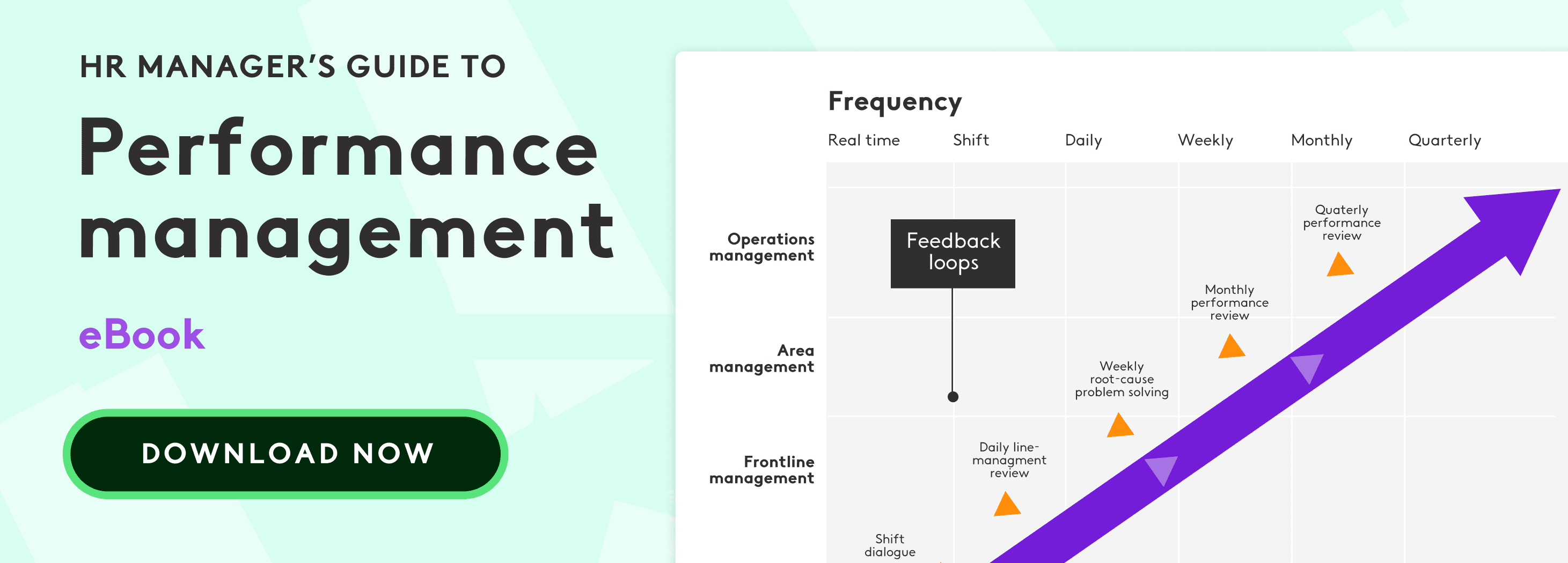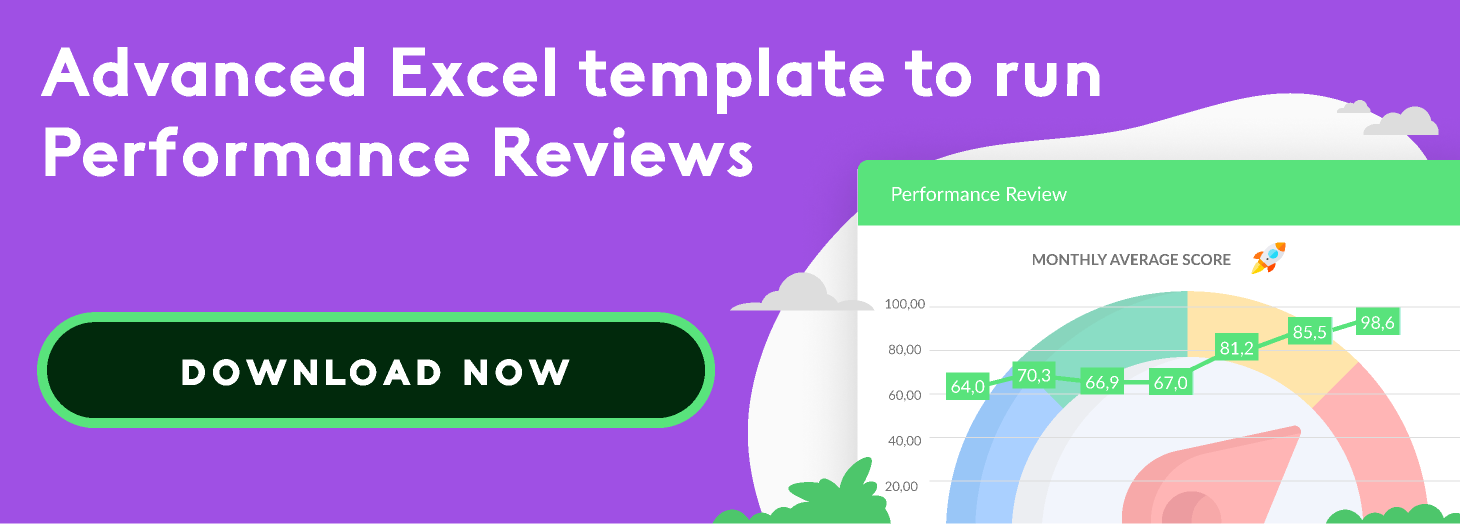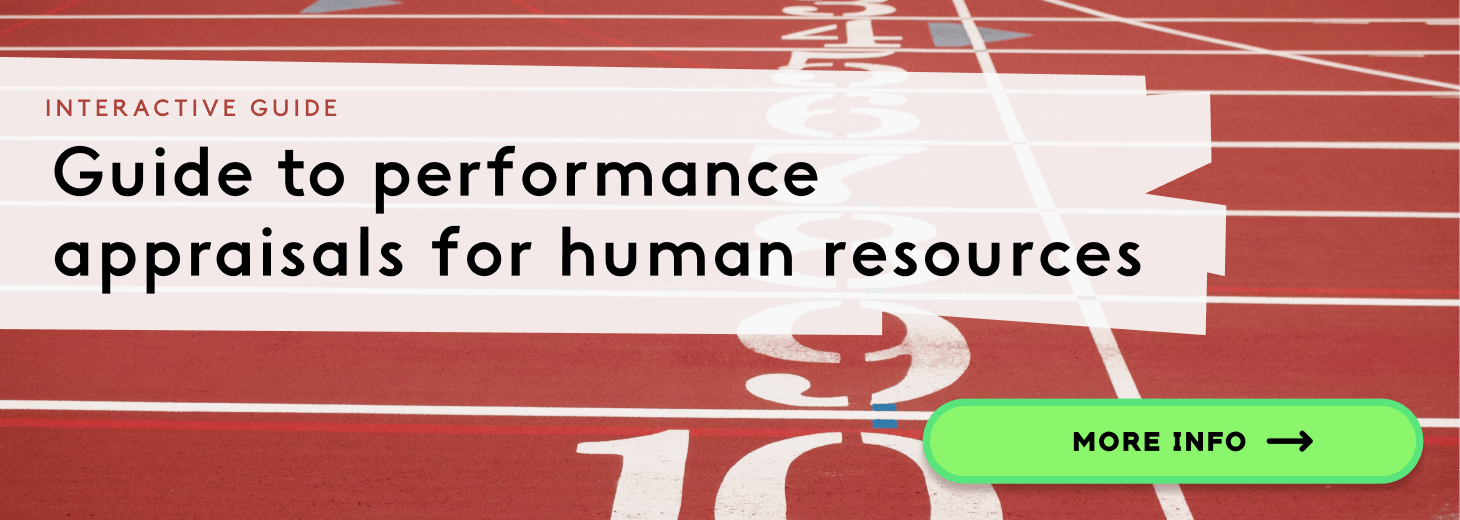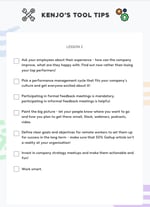Lesson 2: How to create an exceptional performance review

Learn how to get organised and implement the right remote processes and strategies in order to thrive in a remote work environment.
Key Learnings
✓ Performance management.
✓ How employee engagement and satisfaction play key roles in any company.
✓ How to run performance reviews.
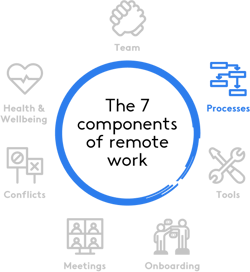
Successful performance management processes
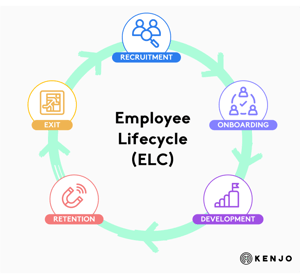 Whether your organisation functions in the office or remotely, you probably have to manage around nine key business processes that support your employees during their time at your firm.
Whether your organisation functions in the office or remotely, you probably have to manage around nine key business processes that support your employees during their time at your firm.
Looking at it from the employee perspective, the average employee goes through a very typical life cycle: (virtual) recruitment, (remote) onboarding, growth and development, more development (and therefore retention), and then seeking an exit opportunity (to develop further).
Looking at it this way, it becomes easy to see that development and retention efforts should be top of mind. For this to happen, two key business processes need to be closely considered:
1) Performance management/ performance review.
2) Employee engagement.
Today we’ll focus on the performance management cycle, and in the next lesson, we’ll focus on employee engagement. Ready to dive in?
Performance Management
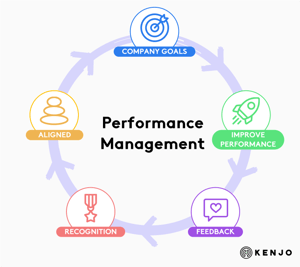 As you know, performance management is a key process that ensures your company’s mission is strategically aligned to every employee's annual objective. The aim is to achieve the company quotas and KPI’s set out by management at the beginning of the year, and as efficiently as possible.
As you know, performance management is a key process that ensures your company’s mission is strategically aligned to every employee's annual objective. The aim is to achieve the company quotas and KPI’s set out by management at the beginning of the year, and as efficiently as possible.
You can think of the performance management cycle as a continuous loop of setting expectations, managing progress, reviewing performance and rewarding results.
We use the term continuous loop to highlight the fact that performance management cycle can (and should) be a continuous process (as in more than once) throughout the year.
Some high performing companies in Berlin actually go through the loop 3x a year! If that seems like a lot of work, don’t worry: our tool will simplify the process for you - click here.
Let’s go through each phase together once:
1. Expectation setting
You can begin this phase once you’re clear about the business objectives for the year. Once they’ve been defined, you can start identifying departmental objectives and the type of skills that are needed to meet the goals. Once assessed, you can hand over the business expectations to department leaders who will then share the goals with their team.
This handover will involve conversations about which tools employees will need to reach their objectives, which learning and development resources are needed, and if there are obvious skills missing that will require a new recruit. Departmental heads will also prepare a document outlining how each employee can set SMART goals.
2. Managing progress
The managing progress is the phase that encourages two-way communication about the expectations set in phase one. This phase is a formal process but we also encourage you to check in with your employees informally. In doing so, you’ll get a sense of how they’re managing and if you need to offer troubleshooting in case problems have arisen.
Here are the types of conversation that help during this phase:
- "I see you’ve been quite busy trying to achieve your goals, how are you managing?"
- "Do you see any potential issues that may prevent you from achieving your goals this quarter?"
- "Do you need any skill development resources?"
3. Reviewing performance
This phase usually occurs at the end of the performance review cycle. It’s a formal conversation that solidifies the progress that has been made, and to ultimately discuss whether goals have been met/ if performance goals have been exceeded. There are various review cycles that companies use. Here is the one that we have developed at Kenjo to boost employee engagement:
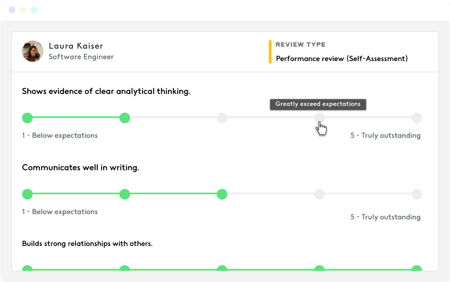
How to organise a performance review:
- OKR at the beginning of the year.
- Expectations explained and agreed for the review cycle.
- Automated email reminders.
- Meeting how to plan it.
4. Rewarding results
 Although we like to believe that all employees are intrinsically motivated to deliver excellent results because they love us and their job so much, some high performers are actually quite extrinsically motivated!
Although we like to believe that all employees are intrinsically motivated to deliver excellent results because they love us and their job so much, some high performers are actually quite extrinsically motivated!
For this reason, there are a ton of ways you can reward employees and we encourage you to have this conversation with them. Here are a few ways to reward positive work performance:
Extrinsically motivated employees:
- End of the year bonus (think, X% of sales).
- Salary band increase.
- Extra holiday time.
Intrinsically motivated employees:
- Involving them in that project they’ve been wanting to work on.
- Title change (think, senior to lead).
- Acknowledging their performance to senior leaders.

Pros and cons of developing a performance management assessment
To successfully manage a PM cycle from start to finish, leadership needs to:
👍👍 Firstly: very clearly state their mission and constantly check the company is aligned, aware of it and can move in the same direction.
Gallup states that only 50% of employees clearly understand what is expected of them and their performance at work. To help manage this, try using the following formats and lean towards overcommunicating the mission and annual objectives.
- A New Year email, giving all employees a full picture of where the company is headed in the next year and any mission-critical objectives they need to be aware of. These objectives can be communicated with a PDF of OKR’s.
- A company strategy slack page, enabling leadership to speak directly to their distributed workforce and give any updates on major milestones.
- Quarterly strategy meetups, in-person meetings to learn about the strategy through listening and action. For example, a quarterly meetup could include a strategy speech from the CEO and a well-thought-out game that gets people on their feet to solve fun and engaging problems directly related to the strategy.
👍👍 Secondly: Provide opportunities for check-ins and feedback before the end-of-year assessments and rewards are handed out. In a remote working environment, there are various performance review processes you can consider.
- No review: You may laugh, but you’d be surprised how many organisations don’t yet have a performance review cycle. We don’t recommend this strategy, so if that’s you, check out our performance appraisal guide and our advanced appraisal template to get started!
- Annual performance review by the line manager: Employees receive a scorecard and an evaluation from their direct line manager every year, based on the manager’s (subjective) assessment of their performance. This is a risky strategy as it leaves all feedback to the very end which doesn’t give the employee a chance to improve or pivot if they need to.
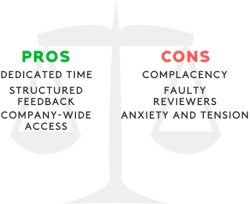
- 360 degree review: An employee receives a single evaluation, put together by their manager, using anonymous feedback given by the employee’s manager, their peers, subordinates and superiors - all of whom they have worked with over a certain time period. These 360 degree review cycles are normally run three times a year to offer continuous feedback and therefore a very transparent opportunity to improve, grow, develop and stay at the company for longer.
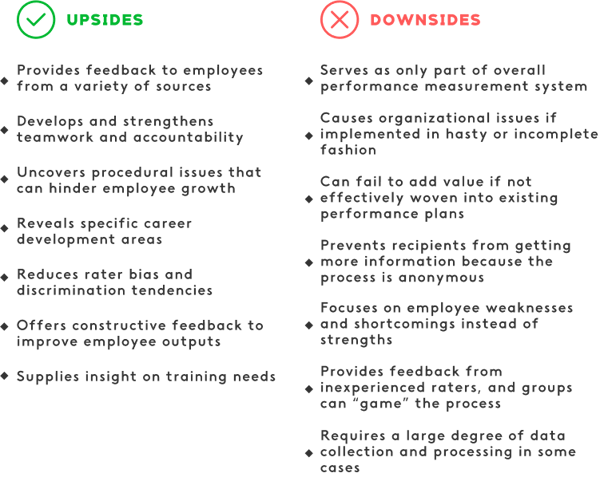
- 180 degree review: Here a professional is evaluated by their manager, their peers and, where applicable, their clients. The difference between this and the 360-degree review is that it doesn’t include subordinates.
- Performance review self-assessment: is part of any employee appraisal and invites them to evaluate their own work. It’s where employees grade themselves and reflect on their contribution to the company becoming aware of their own performance, their potential and their weaknesses. This encourages them to redefine their commitment to the company in line with its mission and goals.

Kenjo performance reviews allow companies to
- help you give more valuable feedback to your employees.
-
Track and manage your future leaders with the talent matrix.
-
Create your own templates or use ours, created by experts.
- 180º, 270º and 360º performance reviews.
Find all infos on performance appraisals for human resources in our interactive guide. 👇👇👇

![]() Ask your employees about their experience - how can the company improve, what are they happy with. Find out now rather than losing your top performers!
Ask your employees about their experience - how can the company improve, what are they happy with. Find out now rather than losing your top performers!
![]() Pick a performance management cycle that fits your company’s culture and get everyone excited about it!
Pick a performance management cycle that fits your company’s culture and get everyone excited about it!
![]() Participating in formal feedback meetings is mandatory, participating in informal feedback meetings is helpful.
Participating in formal feedback meetings is mandatory, participating in informal feedback meetings is helpful.
![]() Paint the big picture - let your people know where you want to go and how you plan to get there: email, Slack, webinars, podcasts, video.
Paint the big picture - let your people know where you want to go and how you plan to get there: email, Slack, webinars, podcasts, video.
![]() Define clear goals and objectives for remote workers to set them up for success in the long term - make sure that those 50% of that Gallup article isn’t a reality at your organisation!
Define clear goals and objectives for remote workers to set them up for success in the long term - make sure that those 50% of that Gallup article isn’t a reality at your organisation!
![]() Invest in company strategy meetups and make them actionable and fun!
Invest in company strategy meetups and make them actionable and fun!
![]() Work smart.
Work smart.
➡️➡️ Print out your Kenjo performance review checklist here to tick what's most important: Download checklist. ⬅️⬅️
What’s coming next?
Next up, you will learn about employee engagement. We will share popular formats that you can use to ensure your people are putting their goals into action!
To learn more about Kenjo’s solution to increase employee satisfaction with employee surveys, click here.
